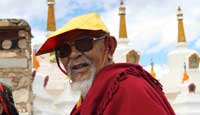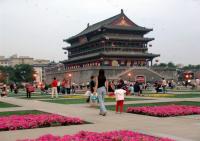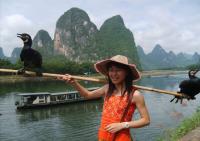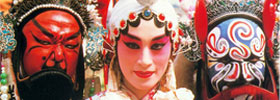Lhasa Fact Sheet
Lhasa is the capital city of Tibet Autonomous Region of China, which is considered to be the center of politics, economy and cultural, communication as well as tourism. It is located in the northern bank of Kyichu River, the main tributary of Yarlung Tsangpo River (Brahmaputra River). It is also an ancient cultural city with a history of 1300 years.
In early times, Lhasa was called Rasa, literally "goat earth". It is said that Lhasa was originally a fenland. At first, the Jokhang Temple was constructed with earth carried by white goats after the arrival of Princess Wencheng to Tibet who suggested to build it. After Songtsen Gampo set up the Tubo Kingdom, he moved the capital to Rasa. It was changed into Lhasa in 19th century, which means "the Holy Land", or "the sacred land" as known till now. With the rapid growth of the Tubo's politics, economy, cultural and Buddhism, the Potala Palace, the Jokang Temple and the Ramoche Temple were gradually built and formed an embryonic-shaped of the old city with the Jokhang Temple as the center. In consequence for over 1300 years, with the regime being renovated, a well-known historical city in palaces, Buddhist halls and inhabitants with uniquely dominant features stood up in the Lhasa valley. Today, the total area of the Lhasa municipality expanded to 31,662 sq. km. with its urban area of 523 sq. km. Which has seven counties and one district under its jurisdiction. The total population in the city is about 495, 000 with 70,000 of people living in the urban district. There are more than thirty ethnic groups such as Tibetans, Hans, and Moslems of which Tibetans make up 87 % of the total population.
Lhasa in Chinese Pinyin: lā sà
Lhasa in simple Chinese and traditional Chinese respectively: 拉萨 拉薩
Coordinates: 91°7′6″ E, 29°36′17.4″ N
Currency: Yuan (Renminbi)
Language: Tibetan Language, Chinese Mandarin
Time Zone: Beijing Time (UTC+8)
Lhasa Area Code: Internal dialing code is 0891 while international telephone calling code is +0086-891.
Administrative Divisions: 1 districts (Chengguan District) and 7 counties (Lhünzhub County, Damxung County, Nyêmo County, Qüxü County, Doilungdêqên County,
Dagzê County, Maizhokunggar County)
Altitude: 3,650 m
City Flower: Rose
Sister Cities: Boulder
Nearby Cities: Shannan (95 km), Shigatse (245 km)
Points of Interest
Potala Palace, Gandan Monastery, Jokhang Temple, Drepung Monastery, Sera Monastery, Romache Monastery, Norbulingka, Barkhor Street, Canggu Monastery, Pabonka
Hermitage
Most popular souvenirs and local products: Tibetan food, crafts, Tibetan rugs, Tibetan knife/
Featured food: Tsampa (the staple composed of barley), balep (bread), thukpa (noodle soup), yak butter, yak cheese, yak yoghurt, raw meat
History
Historical Evolution
618 Songtsan Gampo came to power over his small kingdom after the death of his father.
637 Songtsan Gampo raised the first structures on the site of what is now the Potala Palace on Mount Marpori.
641 Songtsan Gampo constructed the Jokhang and Ramoche Temples in Lhasa.
649 C.E., Chinese troops captured Lhasa and burnt the Red Palace of the Potala Palace.
1246 Yuan Dynasty summon Tibet to surrender, Lhasa became part of the Yuan Empire.
1642 The fifth Dalai Lama, Lobsang Gyatso (1617–1682) moved the centre of his administration to Lhasa
1951 the PLA assumes control Lhasa peacefully.
1960 Lhasa City was set up officially.
Climate
Lhasa features a cold steppe climate (Koppen Bsk). Due to its very high altitude, Lhasa has a cool, dry climate with frosty winters. It enjoys nearly 3,000
hours of sunlight annually and is thus sometimes called the "sunlit city" by Tibetans.
Lhasa has an annual precipitation of 426 mm (16.8 in) with rain falling mainly in July, August and September. The rainy season is widely regarded
the "best" of the year as rains come mostly at night and Lhasa is sunny during the daytime.
Temperature
Daily average (January) 0.9 °C (30.4 °F); (June and July) 16.5 °C (61.7 °F)
Precipitation
Monthly average (January) 0.8 mm (0.03 in); (August) 120.6 mm (4.75 in), daily rate 6.0 mm (0.24 in)
Transportation
Rail
The Qinghai–Tibet Railway which proceeds north and then east to Xining, some 2000 km, goes up to 5,072 meters above sea level, is the highest railway in the
world. Five trains arrive at and depart from Lhasa railway station each day. Train numbered T27 takes 43 hours, 51 minutes from Beijing West, arrives in
Lhasa at 16:00 every day. T28 from Lhasa to Beijing West departs at 13:45 and arrives in Beijing at 08:06 on the third day, taking 42 hours, 21 minutes.
There are also trains from Chengdu, Chongqing, Lanzhou, Xining, Guangzhou, Shanghai and other cities. To counter the problem of altitude differences giving
passengers altitude sickness, extra oxygen is pumped in through the ventilation system, and personal oxygen masks are available on request.[66]
Highway
Sichuan - Tibet Highway, Qinghai - Tibet Highway, Yunnan - Tibet Highway, Xinjiang - Tibet Highway, China - Nepal Highway
Air
Lhasa Gonggar Airport is located about one hour's taxi ride south from the city. There are flight connections to several Chinese cities including Beijing,
Chamdo, Xian, Guangzhou, and Chengdu, and to Kathmandu in Nepal.












